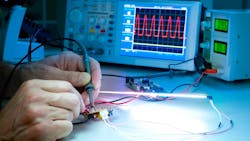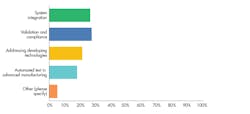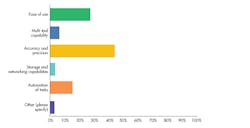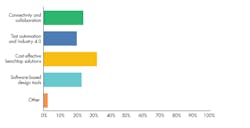Survey Affirms the Ever-Evolving Test Industry’s Expansion
This article appeared in Electronic Design and has been published here with permission.
What you’ll learn:
- The expansion of test & measurement in design and manufacturing.
- Issues impacting the T&M community.
- Observations from the test & measurement survey.
The role of test & measurement engineering in our modern electronic development environment is undergoing a period of expansion in terms of functionality, capabilities, and application, among others. In one sense, the T&M community is a victim of its own success, as many of the latest T&M solutions in the industry aren’t always recognized as such. Design engineering tasks that used to require a bench session or a visit to a development lab can now be done in the cloud on a laptop, blurring the lines between design and development duties.
This isn’t a bad thing. Today, it’s imperative that T&M be integrated into every step of design, development, and manufacturing to achieve the performance and productivity demanded by the modern marketplace. A design can now go from a concept drawing on a datapad, to a file in a collaborative simulation software tool, to a six-sigma smart factory, to over-the-air updates in the field until the product runs out of warranty. Advanced T&M solutions are involved in every step.
We recently held our annual test & measurement industry survey, where several hundred editors provided us with answers to several questions about their work. Design engineers made up 33% of the group, with an additional 17% being directly involved in R&D. Notably, 10% were instructors or teachers, giving us an insight into where we are from that perspective. Interestingly, 7% identified themselves as hobbyists/makers, a demographic growing in both size and importance. Not surprisingly, 80% of the respondents identified themselves as working regularly with T&M technologies.
Challenges in Test & Measurement
Our current electronic development environment is full of design challenges involving the latest technologies and ways to ensure that an application solution has the desired functionality and performance.
When it came to the challenges they’re facing (Fig. 1), our engineering audience was roughly equally split into four blocks, the largest two being those who indicated that system integration was the biggest challenge and those who felt that it was validation and compliance. Addressing developing technologies and the challenges of automated test made up the rest of the bulk of replies.
System integration and compliance and validation are closely related, as the issues of one are manifested in the other. If problems with EMI or RF noise arise in a poorly designed system, it will directly impact the product’s performance when it comes to standards compliance. Of course, integrating the latest technologies in a design can help address these issues, but they typically come with learning-curve and solution maturity challenges.
For example, using wide-bandgap semiconductors can help with power-density and thermal-management issues. However, the higher operating frequencies usually involved with the advanced topologies needed to achieve the promised performance place stresses on the passives and magnetics, which if not properly addressed can lead to cascading problems throughout the circuit. Then, of course, everything must be tested during manufacture, requiring proper design of automated testing stations and processes.
Concerning the Customer
How the T&M industry sees things and how their customers see them often differ due to perspective. When we asked about important test & measurement concerns among their customers (Fig. 2), our respondents told us that accuracy and precision was number one by a wide margin, followed by ease of use and task automation, which are in their own way related. This makes a lot of sense, as it reflects on the engineer’s concern about how to achieve the application performance desired by the customer.
Today’s electronic solutions are noteworthy for their advanced levels of functionality integration, compact dimensions, and wireless capability, and that can only be achieved using the latest T&M tools and methods. The hardest aspect of T&M is that those devices must use the latest technologies and implement them in a way that’s even more accurate and precise than the systems they’re testing. The lines on your ruler have to be closer together than the features you’re trying to measure, or there’s no precision.
The latest T&M solutions can perform tasks and measure things that were either impossible or extremely expensive to do only years ago. In addition, recent events have caused the remote and collaborative aspects of these tools to become more refined.
Integrating multiple subsystems and making them operate properly together, ensuring standards compliance, and establishing an optimal manufacturing process to create the desired product can now be done by a team connected only by their software and hardware development tools.
Current Trends in Test & Measurement
The future is always an uncertain place, and it is hard to predict with any great certainty what will happen in the marketplace. However, trends that are hot today will be of high interest for the foreseeable future. Figure 3 shows the results of our question on trends in test & measurement today. Most answered that cost-effective benchtop solutions were the most important to them, followed by two items that are also related—connectivity and collaboration along with software-based design tools.
This is a direct reflection of the interest the T&M industry has in these new collaborative, electronic system-development software tools, and the force-multiplier they are to a design team. The ability of a team, locally based or far-flung, to collaborate on a circuit, board, package, or process can’t be understated. This ties directly into other smart initiatives like design-for-manufacture and supply-chain management, as well as supporting team flexibility in location and accessibility.
The other trend mentioned ties directly into the leaders, and that’s the growth of test automation and Industry 4.0. These are all connected (no pun intended), as they leverage one another to serve the goal. The simulation software takes supply chain into consideration in parts selection, while the design team also collaborates on how the product will be made and tested. Any issues at any stage are fed back through the system to ensure proper fixes and redesigns are made.
Looking Forward
The test & measurement industry and community is going through a sea change, as the tools and techniques that used to be bench- or lab-based can now be done in software, often in a collaborative fashion. Tests that need to be performed physically, especially those needed to achieve six-sigma manufacturing, can now be done with advanced integrated networked bench tools and ATE setups.
T&M is becoming an ever-more integral part of design, with many T&M functionalities being built into development and manufacturing. As a result, our devices and solutions are more precise, accurate, efficient, and reliable than ever before. There’s no precision without feedback, and the latest in test & measurement tools and solutions provide the best feedback and performance information that has ever been possible to achieve in history.
About the Author
Alix Paultre
Editor-at-Large, Microwaves & RF
Alix is Editor-at-Large for Microwaves & RF.
An Army veteran, Alix Paultre was a signals intelligence soldier on the East/West German border in the early ‘80s, and eventually wound up helping launch and run a publication on consumer electronics for the U.S. military stationed in Europe. Alix first began in this industry in 1998 at Electronic Products magazine, and since then has worked for a variety of publications, most recently as Editor-in-Chief of Power Systems Design.
Alix currently lives in Wiesbaden, Germany.




